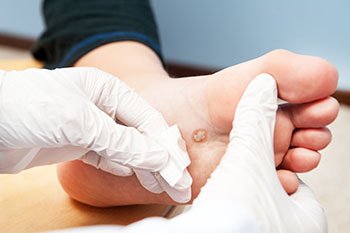
 Warts that grow on the soles of feet are known as plantar warts. These fleshy, grainy patches of raised skin are known for their characteristic tiny, black dots that appear at their centers. Plantar warts are caused by the contagious human papillomavirus (HPV) entering the feet through a crack in the skin. Unlike other types of warts, plantar warts grow inwards, which can make walking uncomfortable. Warts on the feet generally respond well to treatment. If you have plantar warts that are causing you pain or discomfort, are discolored, show signs of infection such as bleeding, scabbing, and pus drainage, or if you have diabetes or an immune deficiency, you should see a podiatrist who can treat the warts and teach you how to prevent recurrences.
Warts that grow on the soles of feet are known as plantar warts. These fleshy, grainy patches of raised skin are known for their characteristic tiny, black dots that appear at their centers. Plantar warts are caused by the contagious human papillomavirus (HPV) entering the feet through a crack in the skin. Unlike other types of warts, plantar warts grow inwards, which can make walking uncomfortable. Warts on the feet generally respond well to treatment. If you have plantar warts that are causing you pain or discomfort, are discolored, show signs of infection such as bleeding, scabbing, and pus drainage, or if you have diabetes or an immune deficiency, you should see a podiatrist who can treat the warts and teach you how to prevent recurrences.
Plantar warts can be very uncomfortable. If you need your feet checked, contact Dr. Robert Hope from Riverside Podiatry. Our doctor will assist you with all of your foot and ankle needs.
About Plantar Warts
Plantar warts are the result of HPV, or human papillomavirus, getting into open wounds on the feet. They are mostly found on the heels or balls of the feet.
While plantar warts are generally harmless, those experiencing excessive pain or those suffering from diabetes or a compromised immune system require immediate medical care. Plantar warts are easily diagnosed, usually through scraping off a bit of rough skin or by getting a biopsy.
Symptoms
Treatment
To help prevent developing plantar warts, avoid walking barefoot over abrasive surfaces that can cause cuts or wounds for HPV to get into. Avoiding direct contact with other warts, as well as not picking or rubbing existing warts, can help prevent the further spread of plantar warts. However, if you think you have developed plantar warts, speak to your podiatrist. He or she can diagnose the warts on your feet and recommend the appropriate treatment options.
If you have any questions please feel free to contact our office located in Tuscaloosa, and Fayette, AL . We offer the newest diagnostic and treatment technologies for all your foot and ankle needs.
 The proper name for a doctor who specializes in foot disorders is known as a podiatrist. The technical term is a doctor of podiatric medicine, and the letters “DPM” follow the doctor’s name. The education that is needed to pursue this form of medicine consists of four years of medical school after obtaining a bachelor's degree. Residency training will take approximately three years, and this is accomplished in hospitals and clinics. Some of the specialties podiatrists are qualified for can include wound care, treating diabetic foot conditions, and performing foot surgery. Common foot conditions many patients seek the expertise of a podiatrist can consist of bunions, hammertoes, heel pain, and various foot infections. If pursuing a career in podiatry is of interest, it is suggested that you speak with a podiatrist who can address any questions you may have.
The proper name for a doctor who specializes in foot disorders is known as a podiatrist. The technical term is a doctor of podiatric medicine, and the letters “DPM” follow the doctor’s name. The education that is needed to pursue this form of medicine consists of four years of medical school after obtaining a bachelor's degree. Residency training will take approximately three years, and this is accomplished in hospitals and clinics. Some of the specialties podiatrists are qualified for can include wound care, treating diabetic foot conditions, and performing foot surgery. Common foot conditions many patients seek the expertise of a podiatrist can consist of bunions, hammertoes, heel pain, and various foot infections. If pursuing a career in podiatry is of interest, it is suggested that you speak with a podiatrist who can address any questions you may have.
If you are experiencing pain in the feet or s, don’t join the stubborn majority refusing treatment. Feel free to contact Dr. Robert Hope from Riverside Podiatry. Our doctor can provide the care you need to keep you pain-free and on your feet.
What Is a Podiatrist?
Someone would seek the care of a podiatrist if they have suffered a foot injury or have common foot ailments such as heal spurs, bunions, arch problems, deformities, ingrown toenails, corns, foot problems, etc.
Podiatric Treatment
A podiatrist will treat the problematic areas of the feet, or lower leg by prescribing the following:
A common podiatric procedure a podiatrist will use is a scanner or force plate which will allow the podiatrist to know the designs of orthotics. Patients are then told to follow a series of tasks to complete the treatment. The computer will scan the foot a see which areas show weight distribution and pressure points. The podiatrist will read the analysis and then determine which treatment plans are available.
If you have any questions please feel free to contact our office located in Tuscaloosa, and Fayette, AL . We offer the newest diagnostic and treatment technologies for all your foot needs.
Read more about What is a Podiatrist? Plantar fasciitis is the most common source of heel pain and is the result of inflammation or a strain of the plantar fascia. The plantar fascia is the flat band of tissue that supports the arch of the foot by running along the bottom of the foot and connecting the heel to the toes. Plantar fasciitis can have a variety of causes. Patients who are obese or have gained weight are susceptible to plantar fasciitis due to the stress the extra weight puts ont the feet. Long distance runners are at a higher risk of developing this condition because of the extreme shock to the heel. Other issues that can lead to plantar fasciitis include a tight Achilles tendon, shoes that don’t fit correctly, a sudden increase in exercise, active jobs, or structural foot problems like flat feet. If you are suffering from heel pain, and you are unsure of the source, a podiatrist will be able to help diagnose and treat your heel pain.
Plantar fasciitis is the most common source of heel pain and is the result of inflammation or a strain of the plantar fascia. The plantar fascia is the flat band of tissue that supports the arch of the foot by running along the bottom of the foot and connecting the heel to the toes. Plantar fasciitis can have a variety of causes. Patients who are obese or have gained weight are susceptible to plantar fasciitis due to the stress the extra weight puts ont the feet. Long distance runners are at a higher risk of developing this condition because of the extreme shock to the heel. Other issues that can lead to plantar fasciitis include a tight Achilles tendon, shoes that don’t fit correctly, a sudden increase in exercise, active jobs, or structural foot problems like flat feet. If you are suffering from heel pain, and you are unsure of the source, a podiatrist will be able to help diagnose and treat your heel pain.
Plantar fasciitis is a common foot condition that is often caused by a strain injury. If you are experiencing heel pain or symptoms of plantar fasciitis, contact Dr. Robert Hope from Riverside Podiatry. Our doctor can provide the care you need to keep you pain-free and on your feet.
What Is Plantar Fasciitis?
Plantar fasciitis is one of the most common causes of heel pain. The plantar fascia is a ligament that connects your heel to the front of your foot. When this ligament becomes inflamed, plantar fasciitis is the result. If you have plantar fasciitis you will have a stabbing pain that usually occurs with your first steps in the morning. As the day progresses and you walk around more, this pain will start to disappear, but it will return after long periods of standing or sitting.
What Causes Plantar Fasciitis?
There are some risk factors that may make you more likely to develop plantar fasciitis compared to others. The condition most commonly affects adults between the ages of 40 and 60. It also tends to affect people who are obese because the extra pounds result in extra stress being placed on the plantar fascia.
Prevention
There are a variety of treatment options available for plantar fasciitis along with the pain that accompanies it. Additionally, physical therapy is a very important component in the treatment process. It is important that you meet with your podiatrist to determine which treatment option is best for you.
If you have any questions, please feel free to contact our office located in Tuscaloosa, and Fayette, AL . We offer the newest diagnostic and treatment technologies for all your foot care needs.
Read more about Plantar Fasciitis
Cracked  heels are a common foot problem that can affect up to one in five adults. While cracked heels aren’t usually a big issue for most, they can lead to discomfort and severe pain. There are a variety of factors that can lead to cracked heels. These include standing for long periods of time, walking barefoot, using harsh soaps, dry skin from the climate, and shoes that don’t support the heels. Medical causes such as a vitamin deficiency, fungal infection, obesity, or pregnancy can also lead to cracked heels. In order to prevent cracked heels, make sure to wear shoes that properly support the heels by avoiding shoes with an open back, tall skinny heel, or shoes that are too tight. Staying hydrated, using a foot cream, avoiding standing in one place for a long period of time, and using custom shoe inserts are all ways to help prevent and treat cracked heels. If you have painful cracked heels, consulting with a podiatrist is suggested for a proper treatment method.
heels are a common foot problem that can affect up to one in five adults. While cracked heels aren’t usually a big issue for most, they can lead to discomfort and severe pain. There are a variety of factors that can lead to cracked heels. These include standing for long periods of time, walking barefoot, using harsh soaps, dry skin from the climate, and shoes that don’t support the heels. Medical causes such as a vitamin deficiency, fungal infection, obesity, or pregnancy can also lead to cracked heels. In order to prevent cracked heels, make sure to wear shoes that properly support the heels by avoiding shoes with an open back, tall skinny heel, or shoes that are too tight. Staying hydrated, using a foot cream, avoiding standing in one place for a long period of time, and using custom shoe inserts are all ways to help prevent and treat cracked heels. If you have painful cracked heels, consulting with a podiatrist is suggested for a proper treatment method.
Cracked heels are unsightly and can cause further damage to your shoes and feet. If you have any concerns, contact Dr. Robert Hope from Riverside Podiatry. Our doctor can provide the care you need to keep you pain-free and on your feet.
Cracked Heels
Cracked heels appear unappealing and can make it harder for you walk around in sandals. Aside from looking unpleasant, cracked heels can also tear stockings, socks, and wear out your shoes. There are several methods to help restore a cracked heel and prevent further damage.
How Do You Get Them?
Dry skin is the number one culprit in creating cracked heels. Many athletes, walkers, joggers, and even swimmers suffer from cracked heels. Age and skin oil production play a role to getting cracked heels as well.
Promote Healing
Over the counter medicines can help, especially for those that need instant relief or who suffer from chronic dry feet.
Wear Socks – Wearing socks with medicated creams helps lock in moisture.
Moisturizers – Applying both day and night will help alleviate dryness which causes cracking.
Pumice Stones – These exfoliate and remove dead skin, which allows for smoother moisturizer application and better absorption into the skin.
Change in Diet
Eating healthy with a well-balanced diet will give the skin a fresh and radiant look. Your body responds to the kinds of food you ingest. Omega-3 fatty acids and zinc supplements can also revitalize skin tissue.
Most importantly, seek professional help if unsure how to proceed in treating cracked heels. A podiatrist will help you with any questions or information needed.
If you have any questions, please feel free to contact our office located in Tuscaloosa, and Fayette, AL . We offer the newest diagnostic and treatment technologies for all your foot care needs.